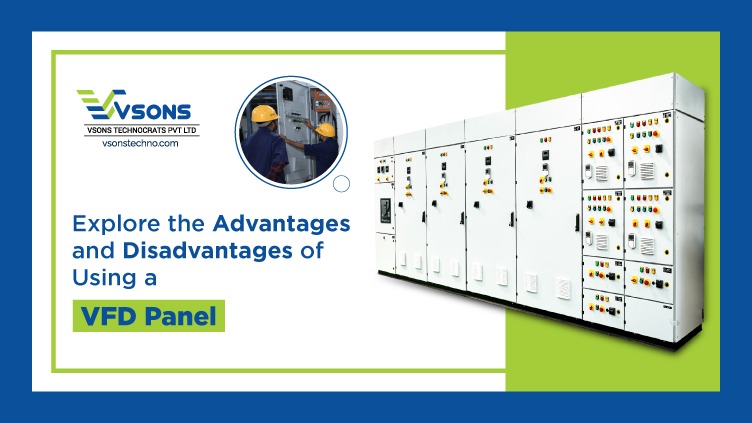Exploring the Advantages and Disadvantages of Using a VFD Panel
- Posted On: December 15, 2023 Posted By: vsons
Variable Frequency Drive (VFD) panels have become indispensable in various industries for controlling motor speed and improving energy efficiency. These panels regulate the frequency and voltage supplied to an electric motor, allowing precise control of its operation. While VFD panels offer numerous advantages, they also come with certain limitations.
In this blog, we will try to briefly understand the advantages and disadvantages of utilizing VFD panels in industrial applications.
Advantages of Using VFD Panels
1. Energy Efficiency
VFD panels work great in energy savings by controlling motor speed according to the load requirements. Traditional methods of motor control, such as throttling valves or dampers, consume more energy at lower speeds. VFDs, on the other hand, adjust the motor’s speed efficiently, reducing energy consumption and operating costs.
2. Enhanced Process Control
These panels provide precise control over motor speed, allowing for better regulation of processes. By adjusting the speed to match specific requirements, VFDs ensure optimal performance and consistent output. This level of control results in improved product quality and process efficiency.
3. Soft Start and Stop
VFD panels facilitate soft starting and stopping of motors, minimizing mechanical stress on equipment and reducing sudden surges in power. This feature extends the lifespan of motors and connected machinery while preventing voltage fluctuations and system wear.
4. Reduced Maintenance
The controlled start-up and operation of motors through VFD panels decrease maintenance needs. Since the motors don’t experience abrupt starts, there’s a reduction in mechanical wear and tear, leading to longer intervals between maintenance cycles and increased equipment lifespan.
Disadvantages of Using VFD Panels
1. Harmonics and Electrical Disturbances
VFD panels might bring in electrical imbalances called harmonics, which could mess with the voltage and impact other gear using the same power. Fixing this might mean adding stuff like filters or extra equipment.
2. Initial Cost and Installation
The starting price tag and setup of VFD panels can be pretty steep. It’s not just the panels themselves – you’re looking at paying for setting them up and even tweaking the system. For some uses, these costs might be a hurdle.
3. Complexity and Maintenance
VFD panels involve complex electronics and programming. Improper installation or configuration can lead to operational issues or increased maintenance requirements. Regular maintenance and skilled technicians are necessary to ensure optimal performance.
4. Motor Heating and Insulation Stress
At lower speeds, motors controlled by VFDs might experience reduced cooling, potentially leading to increased motor heating. Additionally, the switching frequencies in VFDs can stress motor insulation, affecting motor lifespan if not managed properly.
Frequently Asked Questions (FAQs)
Can VFD panels work with any type of motor?
VFD panels usually go well with most AC motors. But, some motors – especially older ones or those with special designs – might need extra attention or changes to work smoothly with VFDs. It’s best to chat with an expert or the manufacturer to make sure everything’s compatible.
Do VFD panels help fix power factor issues?
Yep, they can impact the power factor. When motors run at full speed, VFDs can improve power factor. But if you slow things down, the power factor might drop. Sometimes, you’ll need other gear to fix the power factor when using VFDs at reduced speeds.
What's not so great about VFD panels?
Despite their perks, VFD panels have their downsides. They might mess with the electricity by bringing in harmonics, which could mean extra work to sort out. Also, if they’re set up or programmed wrong, motors might get too hot or cause electrical noise.
Are VFD panels worth it for all uses?
Even though VFD panels save energy, getting them set up and running can cost a lot at the start. For jobs where motors always run at the same speed, the benefits might not outweigh the costs. It’s smart to do the math and figure out if VFD panels make sense for a particular job.
To sum up, VFD panels are awesome for saving energy, controlling processes, and cutting down on maintenance. Evaluating the use of VFD panels presents a nuanced consideration for efficiency and control in electrical systems. While VFD panels, when employedthoughtfully, offer significant advantages in energy savings and motor control, it’s crucial to weigh these benefits against potential drawbacks. Collaborating with reputable Electrical Panel Manufacturers ensures informed decisions and reliable VFD panel solutions, optimizing industrial operations with a balanced approach to efficiency and performance.

